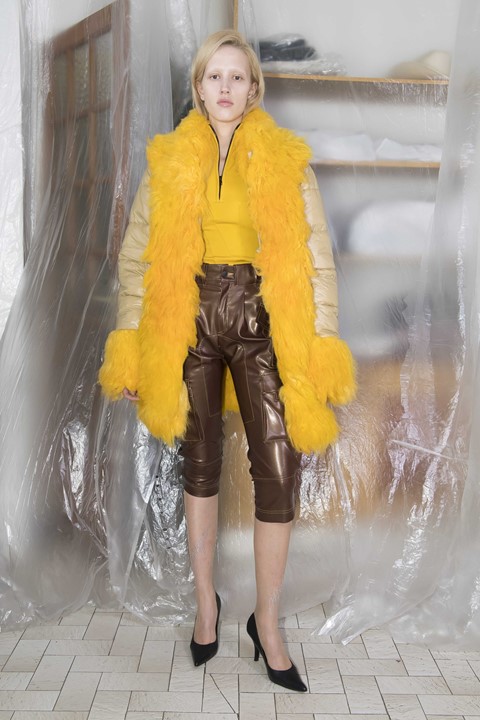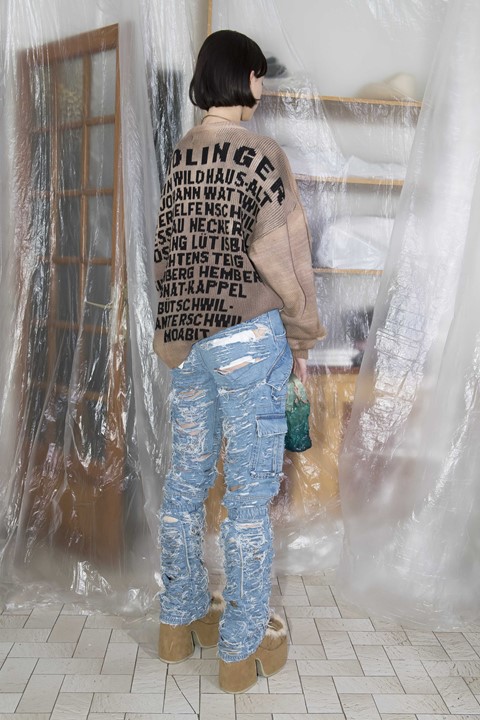Ottolinger combines traditional Swiss techniques with an appetite for destruction
- Who is it? Berlin-based label Ottolinger, begun by Christa Bösch and Cosima Gadient
- Why do I want it? Boundary-pushing womenswear interplaying traditional fabric-making techniques with purposeful destruction
- Where can I find it? Machine-A in London, Farfetch and numerous stockists worldwide
Who is it? Cosima Gadient and Christa Bösch first met while studying at The Institute of Fashion Design in Basel, Switzerland – but Ottolinger, their joint label, was not born until the pair moved to Berlin post-graduation. (The name Ottolinger was already on the doorbell of their first studio and was initially kept for ease of office deliveries – it stuck.) “We moved to Berlin because our friends lived there, and our friends are really important to us,” Gadient says. “There’s lots of people from abroad there; it’s this very wild and interesting mix of people coming together, a whole different culture.”
Ottolinger’s collections, though built on what they observe around them – they note their circle of acquaintances in the German city as a recurring inspiration – begin life back in their home country of Switzerland. There, at the nascent creative stages, Gadient and Bösch work among the country’s traditional craftspeople and mills experimenting with sometimes centuries-old techniques to create fabrics that are entirely their own. “A lot might be typically Swiss, but then we transform it into our line,” Gadient says. “It’s all made and developed by us, the fabrics, the prints… everything.”
If tradition is where a collection begins, their disregard for convention means the end result is anything but. “We’re always expanding our horizons and pushing our boundaries towards a place where we’re not even sure if it’s going to work,” Gadient says. One such example is the purposeful “destruction” of garments – holes might be burnt into fabric (“it creates almost a lace, it’s very delicate,” Gadient decribes), or seams might be frayed, as if on the verge of complete disintegration. In this approach, they might find their forebear in designer Martin Margiela, though, as Gadient insists – “it’s not about deconstruction, it’s more like… reconstruction.”

Why do I want it? “Someone once said something I really like – that they feel like Ottolinger is the cool older sister you never had,” Gadient says. “I think that’s how it grabs people, that it’s something to make you feel confident, or cute, or strong – but it’s also new, unexplored territory.”
As such, they favour a “thrown-on” approach, achieved in part through the pair’s design process, which involves draping directly onto the body rather than beginning with a static sketch. “When we drape, that’s the way we communicate,” Gadient explains. The result, evidenced by their A/W18 collection, is a selection of garments which are entirely eclectic: traditional Swiss checks become swirling Op Art-esque prints across asymmetrically cut dresses and pants; skiwear-style cargo pants are re-made in slashed and torn denim, or cord; while separates in sleek PVC add polish.
Their A/W18 collection – shown as a presentation during Paris Fashion Week earlier this year – also saw them collaborate with British jeweller Joanne Burke and Swiss artist Vittorio Brodmann. “In a big fashion house you have maybe someone who designs jewellery, or accessories or prints,” Gadient says. “We are only small, but we do have this very creative field of friends. It’s like expanding the team for a season.”
And, though they are now finding increasing renown – in part down to their nomination for the LVMH Prize and the stockists that followed – Gadient and Bösch remain insulated in their own world. “It’s something we talked about just recently,” Gadient says of how rapidly things have changed over the past year. “But we really try and work on what we are doing now… It’s only when we go elsewhere that we see people know who we are.”

Where can I find it? Machine-A in London, Farfetch and numerous stockists worldwide.






